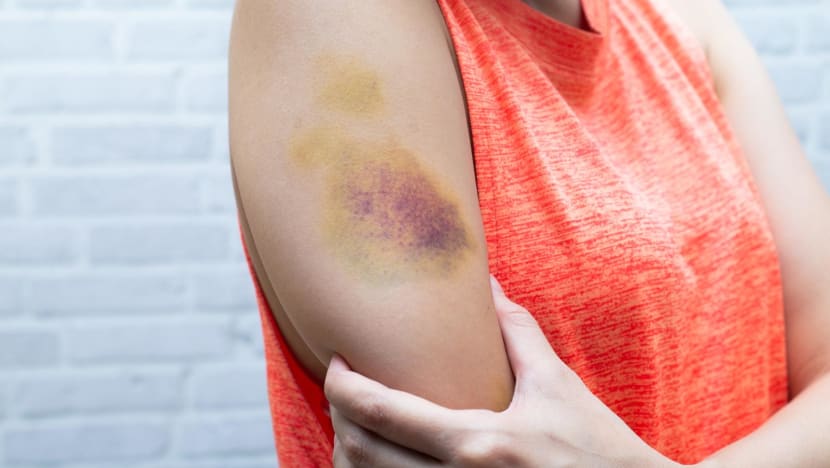Commentary: The hidden plight of parents who are abused by their own children
Amidst the spotlight on domestic violence, a troubling reality emerges: Children who physically attack their parents. Daniel Lopez, President of the Society Against Family Violence, explains the reluctance of parents to speak out.

File photo of a woman with bruises on her arm. (Photo: iStock/Jay_Zynism)
SINGAPORE: Violence comes in many forms and can be directed at anyone. While we often hear about heinous cases of child abuse, spousal abuse, and recently, a concerning rise in elderly abuse in Singapore, there is a lesser-known yet equally distressing issue - children who hurt their parents.
In June, a 16-year-old boy pleaded guilty to three charges of assaulting his mother and one charge of threatening to kill her with a chopper. The boy had started assaulting his mother regularly in 2019, when he was aged 12 or 13, but she did not report any of the assaults to the police. The situation escalated and in November last year, he left her with a fractured rib and bloodied lip and took a chopper to her chest.
In 2020, a student was seen in a viral video repeatedly slapping his mother during an argument over money, sparking a debate about awareness, support, and intervention in such cases.
Before delving into why adolescents might resort to abusing their parents, we must first establish that domestic violence can never be justified under any circumstances. Violence, regardless of age, is a conscious choice.
Similar to other types of violence, child-to-parent abuse remains under-reported and is a pervasive challenge. Research commissioned by the London mayor’s Violence Reduction Unit (VRU) show that 40 per cent of parents and carers who experienced violence by their children between 2011 and 2020 refused to report it.
The reluctance to speak out is often rooted in the dilemma of seeing their own flesh and blood apprehended by the law. Adding to the complexity, victims of adolescent-to-parent abuse encounter a double stigma: Being a victim of domestic abuse and being a parent of a socially defined problematic child.
To address this, we must tackle several essential questions. How can we create a supportive environment where parents feel empowered to seek help without guilt and shame? Are our support networks equipped to handle the complexities of child-to-parent abuse? How can we strike a balance between respecting adolescents' developmental stages and holding them accountable for their actions?
IMITATING BEHAVIOURS IN ENVIRONMENT
Globally, it is estimated that between 5 per cent and 21 per cent of families will experience child-to-parent abuse, according to a study published in the Aggression and Violent Behavior journal in 2018.
My first encounter with adolescent-to-parent abuse was in 2021, as a befriender towards a multi-stressed family.
A mother had called the police after her adopted secondary school-aged son pushed her during a heated argument, causing her to fall over and injure her back on the edge of a door. The force used left her frightened and desperate for help, leading to her making the difficult decision to involve law enforcement.
Further investigation into the family dynamics revealed that the son had endured years of abuse since he was adopted into the family at the age of four.
He had been beaten by hangers, ladles and various other household items. The mother’s justification for these acts was that her son had “pushed my buttons”, supposedly deserving such treatment.
Neurologist Frances Jensen in her book The Teenage Brain highlights that during the pre-teen and teenage years, the most important part of the brain in making decisions and regulating, the frontal lobe, is still developing. She stresses that during this phase, parents should actively model decision-making and, at times, even serve as the frontal lobe for their teens.
Meanwhile, psychologist Albert Bandura’s observational theory posits that children, especially those in the pre-teen years, learn and imitate behaviors from their surrounding environment. Hence, if they see or receive violence, they will likely commit violence. Not always but likely.However, we must note that while upbringing might explain the violent behaviour in the adopted child mentioned earlier, it is not the only explanation why adolescents may be abusive towards their parents.
EXPOSURE TO VIOLENT CONTENT
In today's digital age, children and adolescents have unprecedented access to a wide range of media, including social media platforms, online gaming, and virtual networks.
Exposure to violent content on these platforms can significantly impact their behaviour, influencing their propensity to use aggression to achieve their goals or express themselves.
Research, such as that by Utrecht University’s Hanneke Polman, has highlighted the link between violent video games and aggressive behaviour in children. Data suggests that exposure to violent video games can lead to hostile attribution bias, where individuals perceive social interactions as intentionally hostile by another party.
Within the family setting, this can have adverse consequences when parents attempt to set boundaries, such as limiting screen time, enforcing ground rules, or taking away privileges. Instead of understanding this as discipline, the adolescent may interpret the parents’ actions as hostile behaviour, leading to conflicts and outbursts of aggression.
In the cases that I have encountered, conversations about screen time can escalate into the slamming of tables, brandishing of knives and children punching and kicking their parents.
CONSIDERATIONS FOR CHILDREN WITH SPECIALISED DEVELOPMENTAL PATHWAYS
Another risk factor for adolescent-to-parent abuse is by children with special needs.
In 2015, a study in Spain noted that Attention Deficit Hyperactivity Disorder (ADHD) is a common clinical diagnosis in the adolescents who hurt their parents. Similarly in the United Kingdom, practitioners highlighted neurodivergent attributes in child-to-parent abuse cases.Individuals with ADHD have weaker functioning of the prefrontal cortex, which is responsible for regulating behaviour, attention and emotions. During arguments or conflicts, they may experience heightened emotions that can lead them to act aggressively before consequential thinking kicks in.
Families with children diagnosed with ADHD require specific and early intervention to help manage their behaviour. In Singapore, the Early Intervention Programme for Infants and Children (EIPIC) and SPARK (Society for the Promotion of ADHD Research and Knowledge) offer comprehensive support for families to help identify, manage, and teach effective techniques to boost a child's development and functioning.
ENFORCING THE LAW WHILE BEING DEVELOPMENTALLY SENSITIVE
Considering the above - how adolescents can be influenced by violent environments, media exposure, and their own cognitive and emotional development - and in view of recent legislative amendments giving authorities more power to intervene in family violence cases, it is necessary for enforcers to be developmentally sensitive.
Yes, abuse is wrong and punishments and precautions need to be in place. However, the way we communicate and implement these measures must be tailored differently for adults with fully developed prefrontal cortexes and adolescents who are still developing or have developmental delays.
If a child poses an immediate threat to life or causes harm, measures to remove them from dangerous situations may be necessary. However, even in such cases, enforcers should approach the intervention with the awareness that adolescents require a distinct approach.
Using fear and demeaning language while intervening with adolescents is unlikely to inspire behavioural change because it will increase the fight, flight, or freeze response in them.
Proper training for law enforcement personnel to identify and understand children with developmental delays or difficulties is vital. By being attuned to certain cues, such as restlessness and difficulty in articulating thoughts, enforcers can approach their interactions with adolescents more thoughtfully and empathetically.
IT TAKES A VILLAGE
As much as the saying goes, “it takes a village to raise a child”, the village too is responsible for polluting a child. Parents, educators, and the community should engage in open conversations with children about the media content they consume, helping them develop critical thinking skills to distinguish between fiction and reality.
It is worth considering too if there can be more support in our schools. Currently, all schools have about one to two counsellors, while polytechnics and ITE colleges have about six counsellors each, according to a 2022 parliamentary reply. Amid growing concern over youth mental health, there is a case to be made that this can be improved.
Aggressive habits can also be altered through therapeutic interventions such as behavioural modification, regulation, developing perspective taking, and family-based therapies.
It is crucial not to hastily criminalise adolescents who exhibit disruptive behaviour, but rather, strive for understanding and seek clarification regarding the underlying sources of their discontentment and aggression. Adopting such an approach can lead to enforcers and legislators being equipped with trauma-informed knowledge, potentially opening avenues for family reunification through restorative practices, contingent upon the individuals' willingness to participate.
There is a need too to recognise the need for increased support and funding for social service professionals, particularly those working with young people. Investing in their training, remuneration, and equipping them with specialised skills is vital, as their work with young people shapes our future.
Daniel Lopez is the President of the Society Against Family Violence.


















